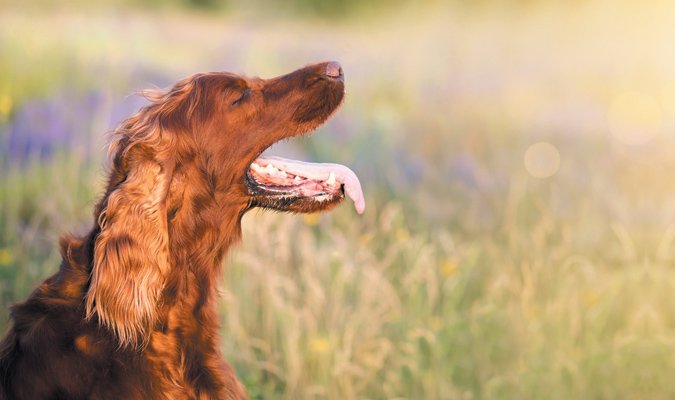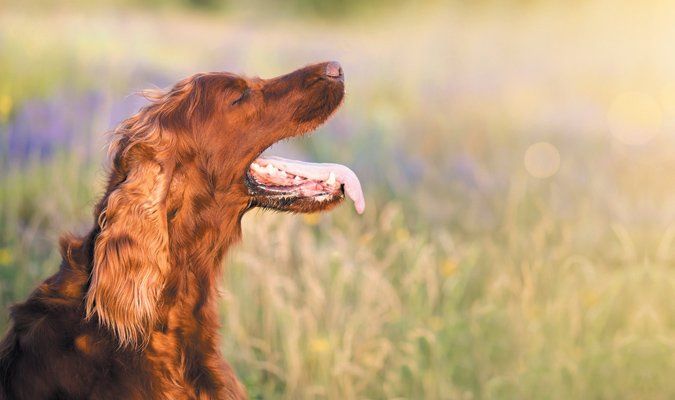
© Reddogs | Bigstock
You find your old pal is having a harder and harder time taking in air, particularly in warm weather or during physical activity. This is not a normal sign of aging. A healthy old dog should be able to breathe comfortably.
There’s a good chance your pet has laryngeal paralysis. It’s one of the five or six most common conditions of older dogs, almost invariably striking those 12 and up. And the dogs affected are almost always large breeds like Labs and golden retrievers. You’d have a hard time finding a miniature poodle with the problem.
Laryngeal paralysis is just what it sounds like — paralysis of the larynx, or voice box. It tends to get worse over time, which is why owners often accept the difficulty breathing as a part of aging rather than as something wrong.
What does the voice box have to do with breathing?
Many people assume that because the larynx houses the vocal chords (hence the moniker “voice box”), it would have nothing to do with breathing. But the larynx has a larger function. As a long, cylinder-shaped organ made of cartilage that lies between the mouth and trachea, or windpipe, its role is to open widely when a dog (or person) inhales so that air can reach the lungs.
That’s why the creeping paralysis, which occurs near the mouth end, causes a problem. If the larynx can’t open properly, the dog can’t breathe properly. Sometimes, the situation gets bad enough that a dog may even collapse at times, or his gums or tongue may turn blue from lack of oxygen reaching all his tissues effectively. His bark may weaken, too.
In some cases, dogs with laryngeal paralysis also develop pneumonia, which may be what brings them to the doctor’s office and leads to a diagnosis. Just as the larynx is supposed to open wide enough to let air in, it’s supposed to close completely during swallowing. But if it’s paralyzed, or partly paralyzed, it won’t close well. Food gets into the lungs, and pneumonia — termed aspiration pneumonia — sets in.
Confirming the diagnosis
Of course, there are a number of reasons a dog may have increasing difficulty breathing. To make sure it’s laryngeal paralysis, the veterinarian will put the dog under light anesthesia and go to the back of his mouth with a laryngoscope — a tubular instrument with a light attached. If the larynx does not open like it should, she will be able to see it right away.
The surgical fix
Once laryngeal paralysis is diagnosed, most veterinarians will refer the dog to a surgical specialist, because the surgery is somewhat demanding and it’s important that the patient be closely monitored during the night after the operation. If it’s a mild case, a wait-and-see approach may be appropriate to find out if the breathing difficulties progress to the point that surgery becomes necessary.
The operation won’t actually fix the paralysis. The nerves that allow the larynx to open and close are permanently damaged, and no surgery can fix them. Rather, the operation is a mechanical way to keep the larynx open permanently.
The most common surgical procedure for achieving that is a laryngeal tie-back. The doctor gets to the larynx via a small incision in the side of the neck and then places two sutures that hold open the front of the larynx on one side, keeping it literally tied back.
The other side remains closed, which lessens the chances that food or saliva will go into the lungs while the open side improves breathing. The risk of food and saliva going the wrong way is highest during the first 24 hours after surgery, because the dog is groggy from anesthesia during that time and may regurgitate in response to anesthetic drugs, then aspirate. There does remain a risk for aspiration pneumonia throughout the dog’s life after the operation — the overall risk is about 25 percent. But fortunately, the majority of aspiration pneumonia cases can be successfully treated with antibiotics.
Owners of older dogs, particularly dogs in the last few years of life, are often anxious about putting their pet through an operation. But afterwards, when the dog seems years younger because of all the energy he now has with his breathing essentially returned to normal, they are glad they made the choice.





